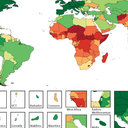Pharmacokinetic and safety profile of desloratadine and fexofenadine when coadministered with azithromycin: a randomized, placebo-controlled, parallel-group study.
Ключови думи
Резюме
BACKGROUND
Significant cardiac toxicity has been associated with some older antihistamines (eg, terfenadine and astemizole) when their plasma concentrations are increased. There is thus a need for a thorough assessment of the cardiac safety of newer antihistamine compounds.
OBJECTIVE
This study was undertaken to assess the effects of coadministration of desloratadine or fexofenadine with azithromycin on pharmacokinetic parameters, tolerability, and electrocardiographic (ECG) findings.
METHODS
Healthy volunteers aged 19 to 46 years participated in this randomized, placebo-controlled, parallel-group, third-party-blind, multiple-dose study. Subjects received desloratadine 5 mg once daily, fexofenadine 60 mg twice daily, or placebo for 7 days. An azithromycin loading dose (500 mg) followed by azithromycin 250 mg once daily for 4 days was administered concomitantly starting on day 3. Group 1 received desloratadine and azithromycin, group 2 received desloratadine and placebo, group 3 received placebo and azithromycin, group 4 received fexofenadine and azithromycin, and group 5 received fexofenadine and placebo.
RESULTS
The results of the pharmacokinetic analysis revealed little change in mean maximum concentration (Cmax) and area under the concentration-time curve (AUC) values for desloratadine with concomitant administration of azithromycin: Cmax ratio, 115% (90% CI, 92-144); AUC, ratio 105% (90% CI, 82-134). The corresponding ratios for 3-hydroxydesloratadine were 115% (90% CI, 98-136) and 104% (90% CI, 88-122), respectively. A substantial increase was observed in mean Cmax and AUC values for fexofenadine when administered with azithromycin: Cmax, ratio, 169% (90% CI, 120-237); AUC ratio, 167% (90% CI, 122-229). Compared with the group receiving desloratadine and azithromycin, subjects receiving fexofenadine and azithromycin also displayed greater variability in pharmacokinetic parameters for the antihistamine. Mean Cmax and AUC values of azithromycin were slightly higher when administered with desloratadine (Cmax ratio, 131% [90% CI, 92-187]; AUC ratio, 112% [90% CI, 83-153]) but were lower when given in combination with fexofenadine (Cmax ratio, 87% [90% CI, 61-124]; AUC ratio, 88% [90% CI, 65-1201). The most common adverse event for all regimens was headache, reported in 20 (22%) subjects. All combinations of desloratadine or fexofenadine with and without azithromycin were well tolerated, and no statistically significant changes in PR, QT, or QT, interval, QRS complex, or ventricular rate were observed.
CONCLUSIONS
Small increases (<15%) in mean pharmacokinetics of desloratadine were observed with coadministration of azithromycin. By contrast, peak fexofenadine concentrations were increased by 69% and the AUC was increased by 67% in the presence of the azalide antibiotic. Based on the reported adverse-events profile and the absence of changes in ECG parameters, the combination of desloratadine and azithromycin was well tolerated. This study suggests that desloratadine has a more favorable drug-interaction potential than does fexofenadine.


